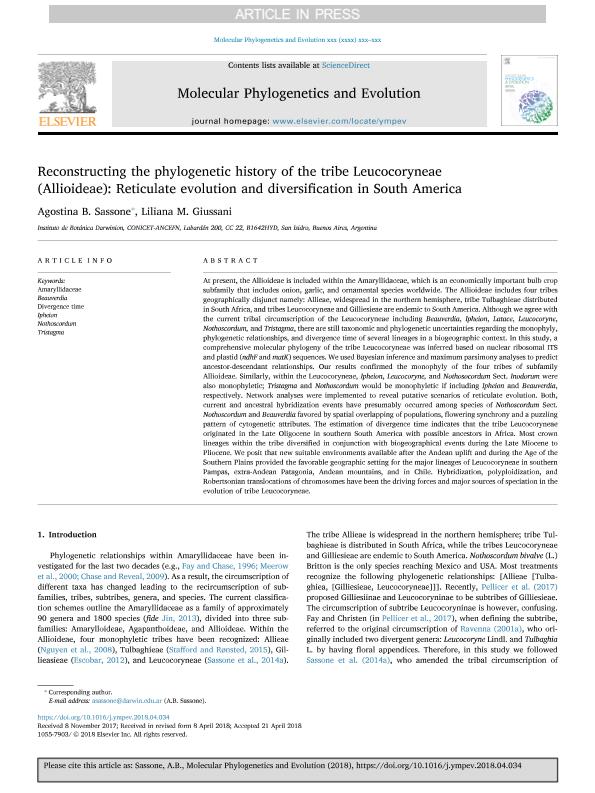Artículo
Reconstructing the phylogenetic history of the tribe Leucocoryneae (Allioideae): Reticulate evolution and diversification in South America
Fecha de publicación:
10/2018
Editorial:
Academic Press Inc Elsevier Science
Revista:
Molecular Phylogenetics and Evolution
ISSN:
1055-7903
Idioma:
Inglés
Tipo de recurso:
Artículo publicado
Clasificación temática:
Resumen
At present, the Allioideae is included within the Amaryllidaceae, which is an economically important bulb crop subfamily that includes onion, garlic, and ornamental species worldwide. The Allioideae includes four tribes geographically disjunct namely: Allieae, widespread in the northern hemisphere, tribe Tulbaghieae distributed in South Africa, and tribes Leucocoryneae and Gilliesieae are endemic to South America. Although we agree with the current tribal circumscription of the Leucocoryneae including Beauverdia, Ipheion, Latace, Leucocoryne, Nothoscordum, and Tristagma, there are still taxonomic and phylogenetic uncertainties regarding the monophyly, phylogenetic relationships, and divergence time of several lineages in a biogeographic context. In this study, a comprehensive molecular phylogeny of the tribe Leucocoryneae was inferred based on nuclear ribosomal ITS and plastid (ndhF and matK) sequences. We used Bayesian inference and maximum parsimony analyses to predict ancestor-descendant relationships. Our results confirmed the monophyly of the four tribes of subfamily Allioideae. Similarly, within the Leucocoryneae, Ipheion, Leucocoryne, and Nothosocordum Sect. Inodorum were also monophyletic; Tristagma and Nothoscordum would be monophyletic if including Ipheion and Beauverdia, respectively. Network analyses were implemented to reveal putative scenarios of reticulate evolution. Both, current and ancestral hybridization events have presumably occurred among species of Nothoscordum Sect. Nothoscordum and Beauverdia favored by spatial overlapping of populations, flowering synchrony and a puzzling pattern of cytogenetic attributes. The estimation of divergence time indicates that the tribe Leucocoryneae originated in the Late Oligocene in southern South America with possible ancestors in Africa. Most crown lineages within the tribe diversified in conjunction with biogeographical events during the Late Miocene to Pliocene. We posit that new suitable environments available after the Andean uplift and during the Age of the Southern Plains provided the favorable geographic setting for the major lineages of Leucocoryneae in southern Pampas, extra-Andean Patagonia, Andean mountains, and in Chile. Hybridization, polyploidization, and Robertsonian translocations of chromosomes have been the driving forces and major sources of speciation in the evolution of tribe Leucocoryneae.
Palabras clave:
AMARYLLIDACEAE
,
BEAUVERDIA
,
DIVERGENCE TIME
,
IPHEION
,
NOTHOSCORDUM
,
TRISTAGMA
Archivos asociados
Licencia
Identificadores
Colecciones
Articulos(IBODA)
Articulos de INST.DE BOTANICA DARWINION (I)
Articulos de INST.DE BOTANICA DARWINION (I)
Citación
Sassone, Agostina Belén; Giussani, Liliana Mónica; Reconstructing the phylogenetic history of the tribe Leucocoryneae (Allioideae): Reticulate evolution and diversification in South America; Academic Press Inc Elsevier Science; Molecular Phylogenetics and Evolution; 127; 10-2018; 437-448
Compartir
Altmétricas




